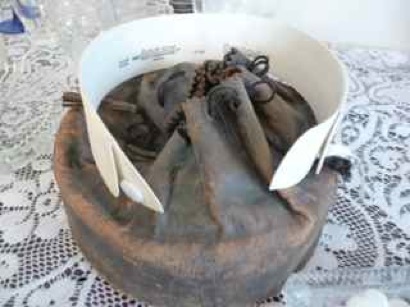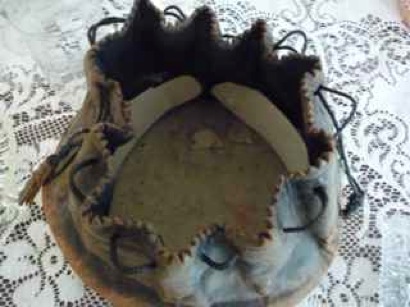
Somewhere in my wanders I picked up this interesting but useless artifact of past life — a soft leather drawstring bag containing two detachable men’s collars and a bag of collar studs. I have no idea when, where, or why I found this treasure, but now seems like as great time to help it find a new home.
You may have seen your male ancestors posing for portraits wearing one of these uncomfortable-looking fashion accessories. Or, maybe you (or your spouse) wore one to a black-tie event? The wing-tip model from Brooks Brothers still looks pretty sharp!
Costume experts attribute the invention of the detachable collar to Mrs. Hannah Lord Montague, a housewife living at #139 3rd Street in Troy, New York in 1827. Mr. Montague and his friends were so impressed with the clever Mrs. M’s invention that local wives and merchants were soon making detachable collar, and the rest is history as Troy became the “Collar Capital of America.”
By 1900, collars were featured with colorful collarless shirts in mail order catalogs and available to every Tom, Dick, and Harry across the nation. According to costumes.org, the most collar style at the turn of the century was the “high-band” collar
a turndown collar with a height of from 2 to 3 inches that encased the whole neck in a smooth glossy cylinder of starched linen. Uncomfortable as these are (turning the head suddenly causes bruises in the bottom of the jaw), they look marvelous, and they made up over 60% of the collar trade in the summer of 1900
My 16-inch Brockley model collars bear the Arrow TradeMark and were manufactured by “Cluette, Peabody & Co. U.S.A.” in Troy, New York.
Detachable collars and cuffs, for both men and women, were such a universal fashion staple that it’s not difficult to find collars, studs, boxes and bags on eBay and etsy sales websites for less than $10 per collar. I’m curious what the prevailing estate sale price will be for this bit of American history. Any ideas?




Did you sell this item yet? I am interested!